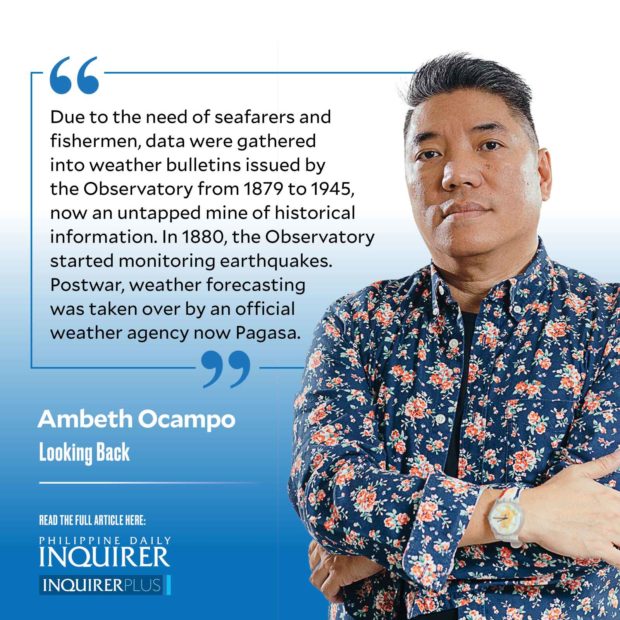Manila Observatory@167
 The Philippine Atmospheric, Geophysical and Astronomical Services Administration is better known to Filipinos by its wonderful acronym Pagasa (Hope). On stormy days, when I was a boy, I would sit beside a radio with my fingers and toes crossed, hoping Pagasa would cancel classes. I learned, later in life, to be careful what I wish for because the forced holiday I welcomed in Manila was dreaded by those in the path or eye of the storm. Crops and homes were devastated by typhoons that hardly made a dent in Manila.
The Philippine Atmospheric, Geophysical and Astronomical Services Administration is better known to Filipinos by its wonderful acronym Pagasa (Hope). On stormy days, when I was a boy, I would sit beside a radio with my fingers and toes crossed, hoping Pagasa would cancel classes. I learned, later in life, to be careful what I wish for because the forced holiday I welcomed in Manila was dreaded by those in the path or eye of the storm. Crops and homes were devastated by typhoons that hardly made a dent in Manila.
Fr. Jett Villarin, SJ, immediate past president of the Ateneo de Manila University, invited me over to the Manila Observatory a month ago to deliver some remarks, not an academic paper with footnotes, just “kwentuhan” as he termed it, to celebrate the 167th anniversary of the Observatory. That a storm disrupted our original schedule was quite appropriate. I spoke mainly about Fr. Federico Faura, SJ, not as the first Observatory director, but as a teacher of a young boy named Jose Rizal, who became the national hero of the Philippines. Padre Faura predicted typhoons based on data, painstakingly gathered by the Observatory and numerous stations in the provinces. That was not his only gift. In 1887, Faura warned the author of “Noli me tangere” that he would end up on the gallows. Nine years later, when Faura went to Fort Santiago to comfort Rizal in his death cell, the author of “Noli” reminded him that his prediction had come true.
The Manila Observatory figures prominently in the history of disasters in the Philippines, and two of its early directors have been honored with street names in the distinguished and ever-loyal city of Manila: Jose Algue in Tondo and Federico Faura in Ermita, though the street signs read P. Algue and P. Faura for Padre Algue and Padre Faura. It is not well known that the present Robinson’s Ermita Mall stands on the site of both the prewar Ateneo and the Manila Observatory after they relocated out of the walls of Intramuros. Postwar, both Ateneo and the Observatory found green pasture in the wilds that is now Loyola Heights, Quezon City.
Article continues after this advertisementToday’s Manila Observatory, with its modern and sophisticated equipment, traces its humble beginnings not to Padre Faura, but to a Jesuit scholastic named Francisco Colina, who established a primitive weather station on the rooftop of the Ateneo Municipal in Intramuros in 1865. Located in an abandoned pigeon coop, it had but four instruments: for temperature, a repurposed household thermometer; for humidity, a homemade Hygrometer, described by Jesuit historian Horacio de la Costa as a “tiny contraption consisting principally of hair”; for atmospheric pressure, a homemade barometer described as “a glass siphon filled with an oily liquid of sickly hue”; and finally for wind velocity and direction, an anemometer made from “a rag fluttering from a length of twine.”
I presume people thought Colina was an eccentric with nothing better to do, but when his daily record, pure raw data, was correlated with a typhoon that struck in 1865, it gave birth to the Observatorio Meteorológico del Ateneo Municipal de Manila. Using better instruments, Faura accurately predicted the approach of typhoons that landed on July 7, 1879, and again in November. These were the first weather bulletins in the Philippines. Due to the need of seafarers and fishermen, data were gathered into weather bulletins issued by the Observatory from 1879 to 1945, now an untapped mine of historical information. In 1880, the Observatory started monitoring earthquakes. By 1884, the Ateneo Observatory was renamed Observatorio Meteorologica de Manila and by royal decree recognized as the official weather forecasting authority for the Philippines. In 1901, under the American colonial administration, the Observatory acted as the Philippine Weather Bureau, until it was destroyed in the 1945 Battle for Manila. Postwar, weather forecasting was taken over by an official weather agency now Pagasa.
So much historical information lies in the archives of the Manila Observatory, and on my quick visit, I already found weather, temperature, cloud information, etc. for Dec. 30, 1896 (Rizal’s execution), and May 10, 1897 (Bonifacio’s execution). Trivial detail to some, but important to a historian taught by the late Teodoro Agoncillo “not to invent or guess anything in history, not even the weather.”
Article continues after this advertisementComments are welcome at [email protected]















